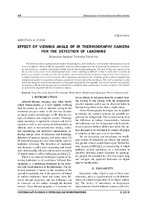| dc.contributor.author | Kurdi, M. Moustafa | |
| dc.coverage.spatial | Минск | ru |
| dc.date.accessioned | 2018-10-26T09:42:55Z | |
| dc.date.available | 2018-10-26T09:42:55Z | |
| dc.date.issued | 2018 | |
| dc.identifier.citation | Kurdi, M. Moustafa. Effect of viewing angle of IR thermography camera for the detection of landmine = Влияние угла наблюдения ИК тепловизионной камеры на обнаружение наземных мин / M. Moustafa Kurdi // Системный анализ и прикладная информатика. - 2018. - №3. - С. 18-24. | ru |
| dc.identifier.uri | https://rep.bntu.by/handle/data/48194 | |
| dc.description.abstract | The detection and recognition of sub-surface buried objects, such landmines, with variable characteristics may be
extremely difficult. Infrared (IR) thermography, which is widely employed in the detection of discontinuities in materials
and structures, would be in principle suitable also for this kind of application. The issue in this case appears to be the presence of excessive levels of background noise, whose modelling is difficult, in that it results from a number of
factors e.g., moisture content, presence of vegetation, and variation of solar radiation at topsoil level. In recent years,
a number of studies have tried to overcome these limitations and improve the reliability of this method, using filtering
and automatic pattern recognition techniques, specific for the detection of buried objects. This work is aimed at revising
and commenting the most recent experiences in this application of IR thermography. The article considers the possibility
of using an IR thermal imaging camera attached to a multifunctional quadrocopter in order to improve the reliability
of detection of ground and buried explosive objects. | ru |
| dc.language.iso | ru | ru |
| dc.publisher | БНТУ | ru |
| dc.title | Effect of viewing angle of IR thermography camera for the detection of landmine | ru |
| dc.title.alternative | Влияние угла наблюдения ИК тепловизионной камеры на обнаружение наземных мин | ru |
| dc.type | Article | ru |
| local.description.annotation | Обнаружение и распознавание взрывоопасных объектов, находящихся на поверхности или на небольшой глубине под поверхностью, таких, как наземные мины с различными характеристиками, может быть чрезвычайно трудным делом. Инфракрасная (ИК) термография, которая широко используется для обнаружения разрывов в материалах и структурах, в принципе подходит и для такого рода применения. Проблема в данном случае, как представляется, заключается в наличии чрезмерных уровней фонового шума, моделирование которого сопряжено с трудностями, поскольку оно обусловлено рядом факторов, например, влажностью, присутствием растительности и изменением солнечной радиации на уровне верхнего слоя почвы. В последние годы в ряде исследований были сделаны попытки преодолеть эти ограничения и повысить надежность обнаружения, используя методы фильтрации и автоматического распознавания образов, характерные для нахождения захороненных объектов. Эта работа направлена на пересмотр и комментирование самого последнего опыта в этом применении ИК-термографии. В статье рассмотрена возможность использования ИК тепловизионной камеры, прикрепленной к многофункциональному квадрокоптеру, с целью повышения надежности обнаружения наземных и погребенных взрывоопасных объектов. | ru |

